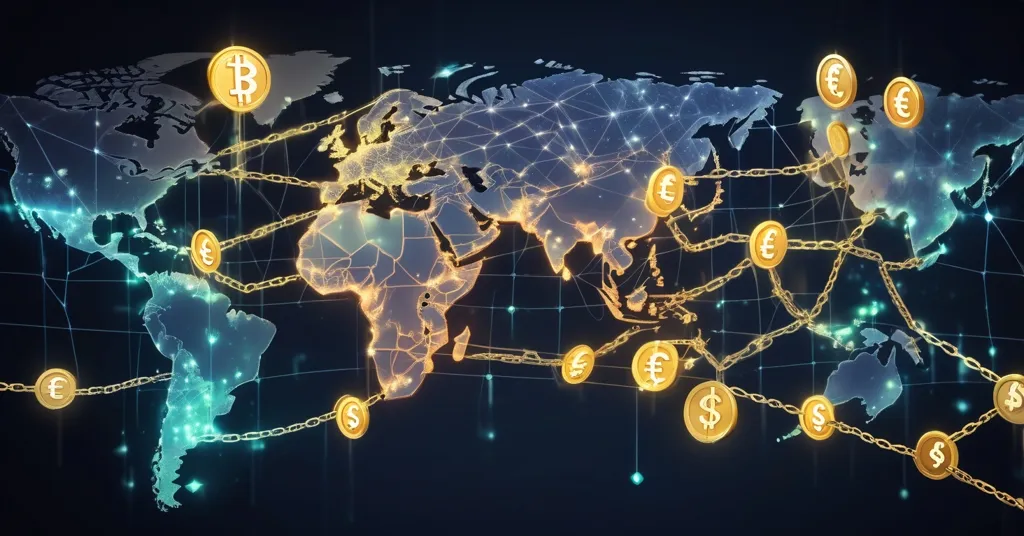Stablecoin Market Booms: Global Shift Beyond USD Challenges Dollar Dominance

Stablecoin Market Explodes: Diversification Beyond USD Signals Global Economic Power Shift
Stablecoins are no longer just a crypto curiosity—they’re morphing into a fierce arena for global financial influence. With a market already worth $100 billion, the push to diversify beyond the U.S. dollar’s chokehold is gaining steam as nations recognize the strategic weight of pegging their own currencies to blockchain tech.
- Market Surge: Stablecoin market valued at $100 billion, with diversification beyond USD picking up pace.
- Global Race: China, Hong Kong, UAE, and others are championing local fiat-backed stablecoins.
- Economic Stakes: Stablecoins are now tools for control over national money and slashing cross-border payment costs.
A Crash Course on Stablecoins and Their Sudden Rise
For the uninitiated, stablecoins are digital tokens tied to real-world currencies like the dollar or euro, designed to hold steady value amidst the rollercoaster of crypto volatility. Imagine them as digital IOUs for actual money, redeemable one-to-one, living on blockchains for fast, borderless transactions. Born from projects like Tether (USDT) and Circle’s USDC, they initially served as safe havens for traders dodging Bitcoin’s wild swings. But over the past 18 months, their usage has doubled—transaction volumes reportedly jumped from $5.9 trillion in 2022 to over $10 trillion in 2023, according to Chainalysis data—thanks to their knack for making cross-border payments faster and cheaper than the outdated, fee-heavy banking systems that still charge an arm and a leg for a wire transfer older than dial-up internet.
Until recently, the stablecoin space has been a U.S. dollar fortress, cementing America’s financial upper hand in the digital realm. That dominance, however, is under siege as countries wake up to the power of fiat-backed stablecoins for asserting control over their own money and boosting economic clout. Let’s unpack how this diversification boom in the stablecoin market is unfolding, who’s leading the charge, and why it matters for the future of finance—and yes, even for Bitcoin purists like me.
Why Stablecoin Diversification Is a Big Deal
The push for diversification isn’t just tech nerds tinkering—it’s about nations reclaiming financial independence. When most stablecoins are pegged to the dollar, countries risk losing grip on their own monetary policies, tethered to U.S. economic whims. Think of it like renting someone else’s house: you can live there, but you’ve got no say over the rules. Local fiat-backed stablecoins—digital versions of a nation’s currency—offer a way to keep payments efficient on blockchain rails without surrendering to foreign influence. Beyond control, they’re a lifeline for cross-border trade, cutting out the middlemen (looking at you, banks) that slow things down and jack up costs. For smaller economies especially, this isn’t a luxury—it’s a survival tactic in a dollar-driven world.
China’s Yuan Play: From Ban to Blockchain Power Move
China’s story is the most jaw-dropping. After banning cryptocurrencies outright in 2021, Beijing has pulled a stunning reversal. Recent moves by the State Council show a clear agenda to promote yuan-backed stablecoins, aiming to elevate the Renminbi’s global reach. Why the flip? It’s not about loving crypto—it’s raw strategy. The yuan accounts for less than 3% of international payments, dwarfed by the dollar’s 50% share, per SWIFT data. Digitizing the yuan on blockchain could turbocharge its use in trade, especially in Asia and among Belt and Road partners, chipping away at U.S. financial supremacy. This isn’t just adoption; it’s a calculated jab in the currency wars, showing how stablecoins are becoming weapons of economic influence.
Middle East and Asia Strike Back
China’s not playing solo. Hong Kong is rolling out sandbox programs, letting stablecoin issuers test local currency tokens under regulatory watch, aiming to position itself as a crypto-friendly hub. Singapore, ever the financial pragmatist, is crafting rules to balance innovation with safety, hoping to lure stablecoin projects tied to its dollar. The United Arab Emirates, with ambitions to be a blockchain epicenter, is eyeing dirham-backed tokens to diversify its economy beyond oil. These regions aren’t just following trends—they’re betting that local stablecoins can shield them from external currency risks while drawing in tech investment. But it’s not all smooth sailing; inconsistent global standards and adoption hurdles could trip up these plans faster than a depegged token.
U.S. Fights to Keep the Upper Hand
Across the Pacific, the U.S. isn’t sitting idle. The dollar’s reign as the world’s reserve currency gives it unmatched staying power, and new legislation like the GENIUS Act is set to reinforce that in the digital space. This bill pushes for clear rules on stablecoin issuance, aiming to keep American firms at the forefront while curbing illicit use. Meanwhile, Wyoming is testing the waters with Frontier, a state-issued, dollar-pegged stablecoin meant for everyday buys—think paying for groceries or gas with a government-backed digital token via your wallet app. It’s early days, with limited merchant uptake so far, but if it catches on, it could normalize stablecoins in ways crypto exchanges never could. These moves show the U.S. doubling down, determined to keep its financial crown even as competitors encroach.
Voices from the Frontlines
Fiorenzo Manganiello, co-founder of LIAN Group and blockchain professor at Geneva Business School, sees this as a tipping point.
“Digital assets are no longer a nice-to-have, and local fiat-pegged stablecoins are fast becoming an economic imperative,”
he argues, emphasizing their role in safeguarding national financial autonomy. He’s even bolder about the timeline, predicting:
“I’m going to go out on a limb and predict that we’ll see 50% of all global currencies featured in the market by next year.”
While ambitious, that forecast seems optimistic at best—regulatory gridlock and tech barriers make such rapid uptake a long shot. Still, the sentiment rings true: stablecoins are shifting from optional to essential for nations eyeing digital relevance.
Risks and Roadblocks in the Stablecoin Rush
Before we get too starry-eyed, let’s talk pitfalls. The stablecoin market isn’t a guaranteed utopia. History gives us grim reminders like TerraUSD’s collapse in 2022, when a so-called “stable” token lost its peg, wiping out $40 billion in value overnight. Depegging risks haunt even well-backed projects if reserves aren’t transparent or liquidity dries up. Then there’s the privacy angle—state-backed stablecoins could easily become surveillance tools, with governments tracking every transaction. For a community rooted in Bitcoin’s ethos of freedom, that’s a bitter pill. And let’s not kid ourselves: regulation, while necessary, can be a creativity killer. If Hong Kong or the UAE overreach, or if global rules clash, innovation could stall out. The dollar’s inertia, too, isn’t just a hurdle—it’s a damn mountain, backed by decades of geopolitical muscle.
Stablecoins vs. Bitcoin’s Ideals: A Necessary Evil?
As a Bitcoin maximalist, I’ll admit stablecoins grate on me. They’re often centralized, tethered to the very fiat systems BTC was built to disrupt. Where Bitcoin offers censorship-resistant money, stablecoins—especially state-issued ones—can be shut down or manipulated by the powers that be. But here’s the devil’s advocate take: they serve niches Bitcoin doesn’t touch. Need to send remittances to family overseas? Stablecoins like USDC can do it in minutes for pennies, while Bitcoin’s volatility might slash your value mid-transfer. In DeFi, they’re collateral kings, powering lending protocols without the risk of price swings. For onboarding the masses to blockchain, stablecoins are a pragmatic gateway, even if they lack BTC’s rebellious soul. If a yuan-backed token gets a billion people using decentralized tech, isn’t that a sneaky win for the broader mission, even if it’s not pure Bitcoin?
What’s Next for Stablecoin Diversification?
Looking ahead, the stablecoin saga is just heating up. The European Union could throw its hat in the ring with a digital euro variant, while smaller nations might piggyback on shared blockchain platforms to launch their own tokens. This ties into the rise of central bank digital currencies (CBDCs), which share DNA with stablecoins but amp up government control—a trend worth watching with both excitement and skepticism. If Manganiello’s 50% prediction is even half-right, we could see dozens of currencies digitized within a few years, reshaping trade and payments. For now, it’s a high-stakes mess worth keeping an eye on. Curious about local stablecoin efforts in your area or blockchain payment tools? Dig into the projects yourself—adoption starts with understanding.
Key Questions and Takeaways on Stablecoin Diversification
- What’s driving the stablecoin diversification boom?
Nations are leveraging stablecoins for economic strategy, faster cross-border payments, and maintaining control over their money against foreign currency reliance. - Why is China pushing yuan-backed stablecoins after banning crypto?
It’s a power play to boost the Renminbi’s global role, using blockchain to challenge the dollar’s grip after a 2021 policy U-turn. - Will the U.S. dollar keep its stablecoin supremacy?
Probably, for now—deep-rooted reserve status and laws like the GENIUS Act give it an edge, but local stablecoin pushes worldwide signal a future threat. - What risks come with the stablecoin surge?
Depegging disasters like TerraUSD, privacy erosion via state tracking, and regulatory overreach could derail the hype if not addressed. - How do stablecoins mesh with Bitcoin’s decentralized vision?
They’re a practical entry point to blockchain for mainstream users, excelling in payments and DeFi, even if they compromise on Bitcoin’s pure freedom ethos.
The stablecoin market is at a crossroads, poised to either redefine global finance or stumble under its own contradictions. Nations are scrambling to digitize their currencies, not out of love for blockchain, but out of necessity in a shifting economic battlefield. Geopolitical rivalries, regulatory tangles, and the dollar’s stubborn reign ensure this won’t be a clean victory lap. Yet, for crypto enthusiasts—from newbies to OGs—the unfolding drama underscores one truth: stablecoins aren’t a sideshow anymore. They’re carving out a massive role in the financial revolution, for better or worse. Stick around—this fight for digital currency clout is just getting started.



